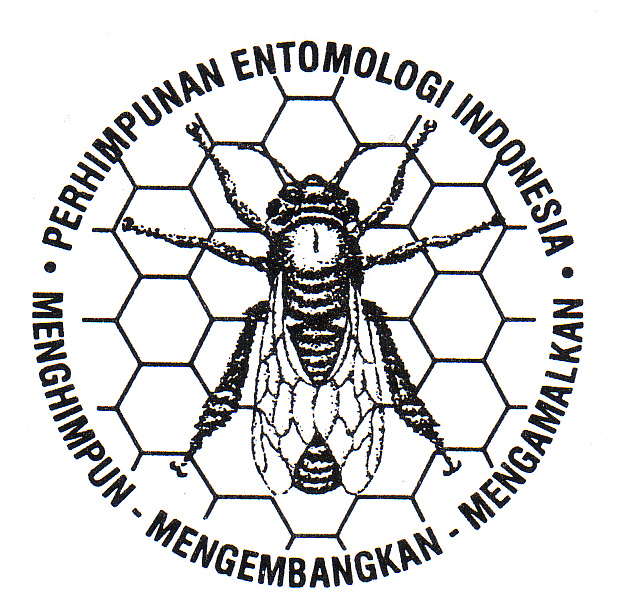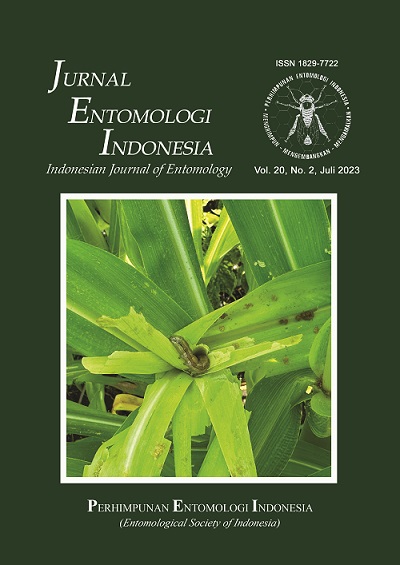Ekspresi morfologi tiga jenis jeruk sebagai indikator ketahanan terhadap serangan Polyphagotarsonemus latus (Banks) (Acari: Tarsonemidae)
DOI:
https://doi.org/10.5994/jei.19.2.100Keywords:
leaf nutrition, population density, plant resistance, Polyphagotarsonemus latusAbstract
One of the important pests of citrus seeds is citrus silver mites (CSM) Polyphagotarsonemus latus (Banks) (Acari: Tarsonemidae). This study aimed to examine the effect of CSM attack on leaf morphology and resistance level of three citrus species. Three types of citrus, namely Tangerine, Mandarin, and Sweet Orange were used as test plants. The shoots of the three types of citrus were tested for nutritional content and five CSM individuals were invested on young leaves that were approximately 10 days old. Observations of CSM population were made 7 days after the investment (DAI) and further observations were carried out every 4 days. The results showed that the lowest abundance of TPJ at 23 DAI was found in type of Tangerine (0.5 ± 0.38 individual) and Mandarin (0.25 ± 0.16 individual). The population of CSM increased at 11 to 15 DAI, and began to decline at 19 DAI. Based on the Pearson correlation analysis, the abundance of CSM was influenced by the fat content and crude fiber content of the leaves. Observations also showed that the Sweet type was more resistant than other types. It can be concluded that the Sweet Orange is more resistant than the Tangerine and Mandarin species.
References
Ammar AM, El Zayyat EA, Khayyal AE, Elleboudy NA. 2021. Population dynamics of some domestic mites in laboratory culture. Journal of Basic and Applied Zoology 85(15):1–8. doi: https://doi.org/10.1186/s41936-021-00213-2
Astoni AM, Puspitarini RD, Tarno H. 2015. Compatibility test of insect pathogenic fungus Beauveria bassiana (Balsamo) Vuillemin (Hypocreales: Cordycipitaceae) with vegetable insecticide extract of putri malu leaves. Journal of Plant Pests and Diseases 3(3):79–86.
Audenaert J, Vissers M, Haleydt B, Verhoeven R, Goossens F, Gobin B. 2009. Acaricides and predatory mites against the begonia mite, Polyphagotarsonemus latus (Acari: Tarsonemidae) on Hederahelix. Communication in Agricultural and Applied Biological Sciences 74(1):1–8. doi: http://dx.doi.org/10.13140/RG.2.1.1695.2167
Brown RD, Jones VP. 1983. The broad mite on lemons in Southern California. California Agriculture 37(7-8):21–22.
Cabedo-Lopez M, Cruz-Miralles J, Peris D, Ibanez-Gual MV, Flors V, Jaques JA. 2021. The response of citrus plants to the broad mite Polyphagotarsonemus latus (Banks) (Acari: Tarsonemidae). Agricultural and Forest Entomology 23(4):1–9. doi: http://dx.doi.org/10.1111/afe.12442
Chapman RF. 2013. The insect structure and function, Fifth Edition. Cambridge University Press. USA.
Childres CC. 1994. Biological control of phytophagous mites in Florida citrus utilizing predatory arthropods. Pest Management in the Subtropics Biology Control – A Florida Prespective. UK. 255–288.
Cohen AC. 2015. Insect diets science and technology, Second Edition. CRC Press. New York.
Fasulo TR. 2010. Broad mite, Polyphagotarsonemus latus (Banks) (Arachnida: Acari: Tarsonemidae). Entomology and Nematology Department, Cooperative Extension Service, Institute of Food and Agricultural Sciences, University of Florida. Diunduh dari http://edis.ifas.ufl.edu. Diakses pada tanggal 7 Februari 2022.
Gerson U. 1992. Biology and control of the broad mite, Polyphagotarsonemus latus (Banks) (Acari: Tarsonemidae). Experimental and Applied Acarology 13:163–178. doi: 10.1007/bf01194934
Grinberg M, Perl-Treves R, Palevsky E, Shomer I, Soroker V. 2005. Interaction between cucumber plants and the broad mite, Polyphagotarsonemus latus: from damage to defense gene expression. Entomologia Experimentalis et Applicata 115(1):135–144. doi: http://dx.doi.org/10.1111/j.1570-7458.2005.00275.x
Hodgson RW. 1967. Horticultural varieties of citrus dalam Reuther W, Webber HJ, Burke JH, Swingle WT, Hodgson RW, Reece PC, Lawton HW. The Citrus Industry Volume 1. Division of Agricultural Sciences. 431–586.
Imbachi K, Mesa NC, Rodriguez IV. 2012. Evaluación de estrategias de control biológico de Polyphagotarsonemus latus (Banks) y Phyllocoptruta oleivora (Ashmead) en naranja Valencia. Acta Agronomica 61:364–370.
Jangra M, Gulati R, Khatak S, Batra VK. 2017. Bioecological studies of Polyphagotarsonemus latus (banks) (acari: Tarsonemidae): A review. Annals of Biology 33(2):319–324.
Martins CC, Alves LFA., Mamprim AP, and Souza LPA. 2016. Selection and characterization of Beauveria spp. isolates to control the broad mite Polyphagotarsonemus latus (Banks, 1904) (Acari: Tarsonemidae). Brazil Journal of Biology 76 (3): 629-637. DOI:10.1590/1519-6984.22614
Mellanby K. 1958. Water content and insect metabolism. Nature 181(4620):1403.
Namvar P, Arbabi M. 2007. Study on biology, population fluctuations and rate of damages of yellow broad mite, Polyphagotarsonemus latus (Acari: Tarsonemidae), on different potato cultivars in Jiroft. Applied Entomology and Phytopathology 74(2):23–43.
Parisi M, Alioto D, Tripodi P. 2020. Overview of biotic stresses in pepper (Capsicum spp.): sources of genetic resistance, molecular breeding and genomics. International Journal of Molecular Sciences 21(2587):1–39. doi: http://dx.doi.org/10.3390/ijms21072587
Puspitarini RD, Fernando I, Rachmawati R, Hadi MS, and Rizali A. 2021. Host plant variability affects the development and reproduction of Tetranychus urticae. International Journal of Acarology. DOI: 10.1080/01647954.2021.1915377
Puspitarini RD. 2011. Phytophage mites in agriculture and plantation in Indonesia. Penerbit Selaras. Malang.
Rodriguez IV, Cobo NCM, Valencia MO, Ossa J. 2017. Population parameters and damage of Polyphagotarsonemus latus (Acari: Tarsonemidae) in Valencia orange (Citrus sinensis [L.] Osbeck) crop. Acta Agronomica 66(4): 633–640. doi: https://doi.org/10.15446/acag.v66n4.59922
Toepfer S, Fallet P, Kajuga J, Bazagwira D, Mukundwa IP, Szalai M, Turlings TCJ. 2021. Streamlining leaf damage rating scales for the fall armyworm on maize. Journal of Pest Science 94:1075–1089. doi: https://doi.org/10.1007/s10340-021-01359-2
Tuda M. 2011. Evolutionary diversification of bruchine beetles: climate-dependents traits and development associated with pest status. Bulletin of Entomological Research 101:415–422. doi: 10.1017/S0007485310000660.
Vacante V. 2009. Citrus Mites: Identification, Bionomy and Control. CABI Publishing. UK.
van Maanen R, Vila E, Sabelis MW, Janssen A. 2010. Biological control of broad mites (Polyphagotarsonemus latus) with the generalist predator Amblyseius swirskii. Experimental and Applied Acarology 52: 29–34. doi: 10.1007/s10493-010-9343-2
Vichitbandha P, Chandrapatya A. 2011. Broad Mite Effect on Chili Shoot Damage and Yields. Pakistan Journal of Zoology 43(4):637–649.
Willis M, Wahyono TE. 2014. Compatibility of entomopathogenic fungal strains and vegetable insecticides for the control of Helopeltis antonii sign. National Seminar on Organic Agriculture. Bogor. 329-336.
Wuryantini S, Puspitarini RD, Affandhi A. 2014. Influence of citrus species to biology and development of citrus silver mite Polyphagotarsonemus latus (Banks) (Acari:Tarsonemidae). IOSR Journal of Agriculture and Veterinary Science 7(2):54–59. doi: http://dx.doi.org/10.9790/2380-07225459
Zhang ZQ. 2003. Mites of greenhouse. CABI Publishing. USA.
Downloads
Published
How to Cite
Issue
Section
License
Copyright (c) 2022 Susi Wuryantini, Otto Endarto, Muhammad Ihsan, Hasim Ashari

This work is licensed under a Creative Commons Attribution 4.0 International License.
Authors who publish with this journal agree to the following terms:
- Authors retain copyright and grant the journal right of first publication with the work simultaneously licensed under a Creative Commons Attribution 4.0 International License that allows others to share the work with an acknowledgement of the work's authorship and initial publication in this journal.
- Authors are able to enter into separate, additional contractual arrangements for the non-exclusive distribution of the journal's published version of the work (e.g., post it to an institutional repository or publish it in a book), with an acknowledgement of its initial publication in this journal.
- Authors are permitted and encouraged to post their work online (e.g., in institutional repositories or on their website) prior to and during the submission process, as it can lead to productive exchanges, as well as earlier and greater citation of published work (See The Effect of Open Access).








